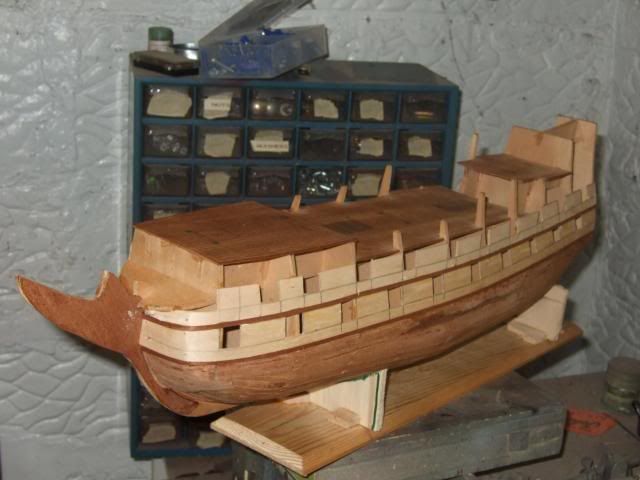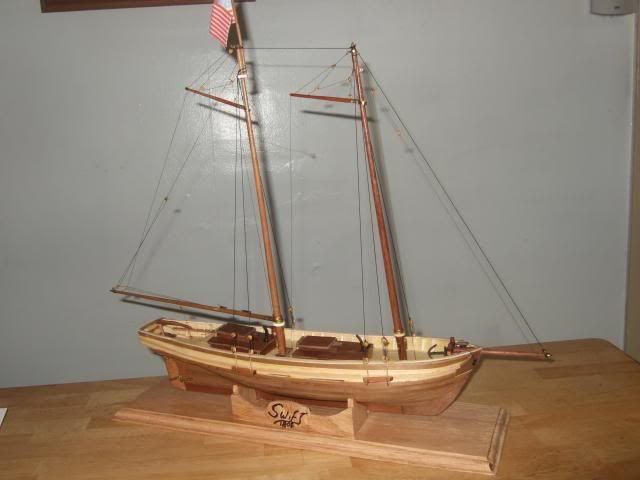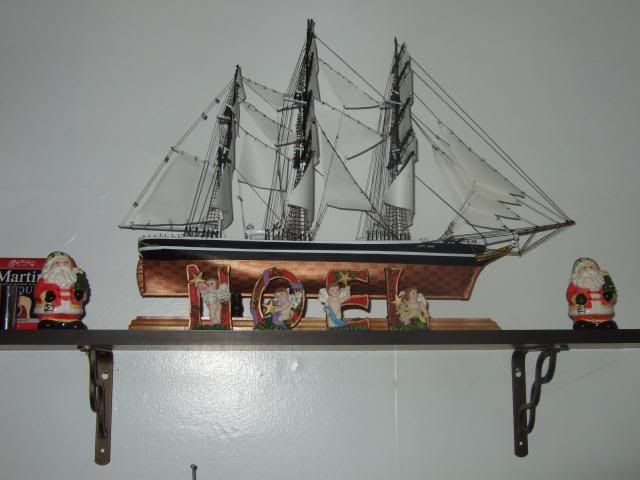Much different than plastic the whole concept is different.You take a few plywood cutouts and plank up the hull.Along the way you have to learn to bend planks sometimes to rather extreme curves without shattering the planks.What a way to expand your modeling skills! 
I built plastic ships for years. 4 years ago, I built my first wooden ship and am hooked. Nothing against plastic models, but I now find them not as much fun to build. I went back to a plastic ship earlier this year when I built Tamiya’s 1/350 scale USS Missouri. I love the ship, but found it somewhat boring even though I did all the usual PE upgrades. I am now putting the final touches on the 2nd hull planking of AL’s Mayflower. It will be a long time before I build another plastic ship.
AHA! :
Now you have brought up a great subject here .Let me expand on it if you don’t mind . I agree with your whole assesment of wood ship modeling .I do have to say , Anyone who has done one can indeed use all skills learned on a wood model and transfer it to plastic and even metal !
I know , you’re saying how ? Well planking for instance .You can heat and shape plastic strips and mount them .The result a planked ship that is the right appearance for the era , but smoother as a result of chosen material .
Try this ,Cut your keel out of quarter inch lexan . The frames are eighth inch lexan .Now you plank with those thin Evergreen strips .You are doing exactly what the wood ship modeler does with one exception ,Well two .You are dealing with all the inherent problems of building a ship model this way AND you are dealing with the problems inherent with the materials you are using .
Can each ship be judged the same ? NO ! Why ? Again it comes down to materials . Either one will test your skills .I think each and every ship modeler should build at least one vessel out of wood .I don’t think type is important .This will indeed push your skills to the limit and you will learn new and interesting ways of building in general.
Look at the photo . Now this ship will live because you wish it so .Therefore you step up to the challenge to your skills and can look forward to the experience and think to yourself I did it right and look at the results .meanwhile when somenoe comments on the skill you used you’er thinking " yeah , and I learned a whole lot of new stuff along the way too " This is what modeling is all about . Tanker - Builder
I remember IPMS while they still had the “plastic content” rule for contest entries. Didn’t join the group until they got rid of that.
I’m an old timer- old enough to remember when airplane and car kits were also made from wood! And wood is a cheap and versatile scratch-building material. I think those of us who grew up in the wood era are more likely to attempt scratch models and drastic mods, since we learned to work with wood and other materials.
In fact, a kit in those days was little more than a set of plans and various hunks of wood in stock sizes, usually pretty much unshaped. Maybe the sheet wood was printed with ink to outline the parts that you cut from the wood sheets. Sometimes aircraft fuselages were cut in profile, sometimes in both profile and planform. You had to shape it from there. Other times the fuselage consisted of a block of wood and you transferred the patterns to the block with carbon paper.
Ship kits were a block of wood for the hull, often preshaped to profile and planform, but you still had a lot of carving to do. Deckhouses were sheets of wood with planforms of parts inked on them, to be cu with hobby knife or razor blade. Masts, even for sailing ships, were just lengths of dowels- you had to taper them yourself. Built a number of ship kits from Sterling and Guillows. Sterling also made kits with sheet material for sides, bottoms and bulkheads, made for installation of electric motors.
I’m going to try one eventually. What I really want to build is a wood U.S.S. Constitution. It may not be ideal though to start off with something so elaborate. I don’t know. I picked up a Midwest Products wood model of a skiff that was on the clearance rack at the local Hobby Lobby a while back. That might be a more appropriate wood model to start off with.
My first wooden plank on bulkhead boat was the AL Swift pilot boat.Learned a lot along the way and it did come out quite well.I get lots of compliments on it! 
I too have built in wood, but like plastic as it is more forgiving. Having said that the majority of my restoration business if wooden models.
Yes, wood is fun…I prefer composite builds…were using large plastic hulls completed in some wood and then everything else is made from wood…
I prefer kit bashing…using some plastic and some wood to complete the model.
Rob
There is still a lot of people who scratchbuild wooden ship models. I don’t know whether it is chicken or egg- more scratch builders because of more scale drawings, or more scale drawings available because more modelers scratch ships, but the art of scratch building ships is still alive and well. Many dozens, maybe hundreds of scale ship drawings out there.
For scratch builders, wood is cheap, too. I can build a 1:196 steamer with about twenty bucks worth of wood. Sailing ships raise price because I buy fittings and fittings definitely cost way more than the wood. Even so, a scratch sailing ship even when buying all fittings is a fraction of cost of any kit.
Don, where could one find scale drawings of ships? Not only scale drawings of ships but scale drawings of other subjects…planes, armor, etc…if any exist. Having not yet tried my hand at scratch building an entire model I’ve often wondered how scratch builders know what size their parts need to be. Do they have scale plans to go by or do they just make the best educated guess they can based on extensive research?
Great Topic!
I find myself in your same frame of mind (NO PUN ABSOLUTELY INTENDED!) Going back to plastic kits almost feels like being a kid again and going back to a snap-tite kit after you did glue models for awhile. I LOVE the way wood kits look, and it always seems people are more impressed by them. As if that Fletcher class destroyer simply popped out of the box with PE hand rails and radar masts already on it…
I don’t know what it is about the perception folks have with plastic models not being as hard to build, paint and finish. This astounds me as most of the population has never attempted anything more difficult than building a volcano out of styrofoam for 6th grade science class!
For some reason wood still holds a societal mystique among our modern world. Maybe it is all that IKEA furniture that comes in a flat box that makes people appreciate these kits more? I am sure there is a sociology paper in this topic somewhere…
Rant complete, great topic!!!
Plastic models(ship models) in the hands of a skilled builder…can be more impressive then a wood model in the hands of most…IMV.
I prefer to re-engineer models for my own purpose…and that typically means using large 1/96 scale plastic hulls…refigured with wood…then all other items made from wood or composite materials.
Kinda like using any and every media to get the job done.
Example: 1/96 revell Cutty Sark composite.

Example: 1/96 Revell CS hull modified into the Glory of the Seas…(Plastic hull…wood mods, masts, houses) Etc.

Example: Modified Revell 1/96 CS modified into Ferreira(wood mods and masts)

Last example: Modified hull of 1/96 Revell CS into Clipper Donald McKay(wood mast, hoses, deck) etc… on open ocean diorama

This is, of course, one of the most hotly argued topics in the modeling world. To my notion there’s no definitive answer - except my favorite answer to most modeling questions: to each his/her own.
Surely the biggest reason for the popularity of wood for models is obvious: wood’s been around longer. People were building ship models out of wood for (literally) thousands of years before anybody built models of anything out of plastic. People whose knowledge of model building consists of having seen a few models in a museum naturally take it for granted that ship models are “supposed” to be made out of wood.
I refuse to categorize one material generally as “better” than another. Anybody who’s seen one of the great (wood) “board room” models from the seventeenth or eighteenth century surely has been blown away. And the detail on some of the plastic and resin kits available today certainly blows me away. I’ve made the following point before, and I’ll stand by it: as a practical matter the mold making and casting processes today are capable of producing far finer detail than any modeler can achieve by hand. (If you don’t believe it, take a close look at an LP record.)
And I think anybody who’s worked much with wood will confirm that it produces a type of satisfaction that’s different (notice I didn’t say “greater”) than a plastic kit can give. But the same can be said about working from scratch in styrene - or, for that matter, metal. (I’ve never scratchbuilt a working steam locomotive, but I imagine the guy who does gets at least as much of a high out of watching it chug around the track as I got when I finished my scratchbuilt Hancock.)
What bother me are the people who do contend that “real ship models are made of wood, and plastic ones are fakes.” Those people just don’t know much about plastic models. I’m particularly galled by the people who build those awful HECEPOB (Hideously Expensive Continental European Plank-On-Bulkhead) kits, and think the grossly inaccurate finished products are “better” than a genuine scale model that’s made out of plastic. I once dropped out of a ship modeling web discussion group because it literally banned plastic models. That strikes me as a great way to shoot oneself in the foot.
My own personal approach is to use whatever material I think is best for the particular job at hand. That little Hancock model contains basswood, boxwood, pearwood, holly, styrene, britannia metal, brass, steel, silk, silkspan tissue, silver/tin solder, nichrome wire, copper wire, and probably a dozen or so other substances that I can’t think of - plus walnut, plywood, velvet, and plexiglas for the case. My personal list of no-no’s consists of two materials: lead (because it’s one of the least stable substances on earth) and balsa wood (because I hate it).
Personally, I’ve always had a little trouble with the idea of building a model of a modern, iron or steel ship out of the wood. It just doesn’t seem quite logical. But we’ve all seen magnificent wood models of battleships, liners, and destroyers. Please don’t try to tell me that wood is the “only legitimate” material for a modern steel hull, though.
It’s a great hobby - and, to my notion, more than that: some ship models rise to the level of art. But I don’t think modeling in general benefits from trying to impose universal value judgments or rules on it. I repeat - to each his/her own.
I think, for me at least, the mystique of wood models is that unlike plastic models, practically every single piece has to be constructed out of stock material. To attain the level of detail that I have seen on some wood models is quite a stunning accomplishment and a result of countless hours of work that I can not even begin to imagine doing. One of the reasons I like plastic so much is that I can finish a model relatively quickly. There’s just too many ships that I want to build to spend two or three years on one alone.
Well put, JTilley…
Please don’t misunderstand me,When I started this thread,I extolled the virtues of building wooden ship models.I never denigrated plastic models and think that wooden ship models are a fun adjunct to not a replacement of plastic as a modeling material.One of the most attractive aspects of scale modeling is the wide variety of subjects techniques and materials,It is never boring and always interesting!.
